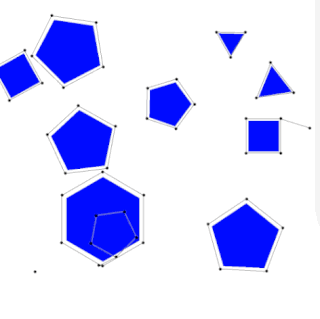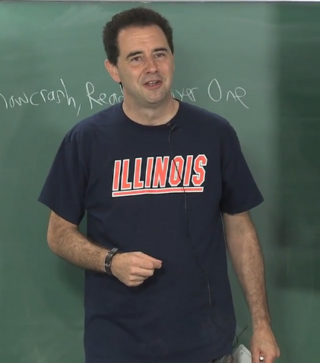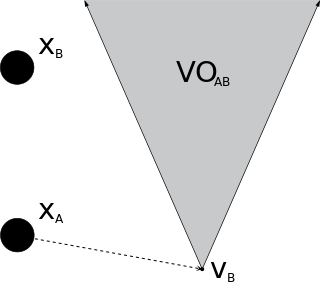Reinforcement learning (RL) is an interdisciplinary area of machine learning and optimal control concerned with how an intelligent agent ought to take actions in a dynamic environment in order to maximize the cumulative reward. Reinforcement learning is one of three basic machine learning paradigms, alongside supervised learning and unsupervised learning.

Dario Floreano is a Swiss-Italian roboticist and engineer. He is Director of the Laboratory of Intelligent System (LIS) at the École Polytechnique Fédérale de Lausanne in Switzerland and was the founding director of the Swiss National Centre of Competence in Research (NCCR) Robotics.
Markus Hendrik Overmars is a Dutch computer scientist and teacher of game programming known for his game development application GameMaker. GameMaker lets people create computer games using a drag-and-drop interface. He is the former head of the Center for Geometry, Imaging, and Virtual Environments at Utrecht University, in the Netherlands. This research center concentrates on computational geometry and its application in areas like computer graphics, robotics, geographic information systems, imaging, multimedia, virtual environments, and games.
Motion planning, also path planning is a computational problem to find a sequence of valid configurations that moves the object from the source to destination. The term is used in computational geometry, computer animation, robotics and computer games.
Obstacle avoidance, in robotics, is a critical aspect of autonomous navigation and control systems. It is the capability of a robot or an autonomous system/machine to detect and circumvent obstacles in its path to reach a predefined destination. This technology plays a pivotal role in various fields, including industrial automation, self-driving cars, drones, and even space exploration. Obstacle avoidance enables robots to operate safely and efficiently in dynamic and complex environments, reducing the risk of collisions and damage.

The probabilistic roadmap planner is a motion planning algorithm in robotics, which solves the problem of determining a path between a starting configuration of the robot and a goal configuration while avoiding collisions.

Steven M. LaValle is an American computer scientist, and a professor in the Faculty of Information Technology and Electrical Engineering at the University of Oulu. He was also an early founder and head scientist of Oculus VR until it was acquired by Facebook in 2014. He is best known for his work on rapidly exploring random trees (RRTs), the Oculus Rift, and his book, Planning Algorithms, one of the most highly cited texts in the field.
In robotics, Vector Field Histogram (VFH) is a real time motion planning algorithm proposed by Johann Borenstein and Yoram Koren in 1991. The VFH utilizes a statistical representation of the robot's environment through the so-called histogram grid, and therefore places great emphasis on dealing with uncertainty from sensor and modeling errors. Unlike other obstacle avoidance algorithms, VFH takes into account the dynamics and shape of the robot, and returns steering commands specific to the platform. While considered a local path planner, i.e., not designed for global path optimality, the VFH has been shown to produce near optimal paths.

In robotics and computer vision, visual odometry is the process of determining the position and orientation of a robot by analyzing the associated camera images. It has been used in a wide variety of robotic applications, such as on the Mars Exploration Rovers.

In robotics and motion planning, a velocity obstacle, commonly abbreviated VO, is the set of all velocities of a robot that will result in a collision with another robot at some moment in time, assuming that the other robot maintains its current velocity. If the robot chooses a velocity inside the velocity obstacle then the two robots will eventually collide, if it chooses a velocity outside the velocity obstacle, such a collision is guaranteed not to occur.

Any-angle path planning algorithms are pathfinding algorithms that search for a Euclidean shortest path between two points on a grid map while allowing the turns in the path to have any angle. The result is a path that cuts directly through open areas and has relatively few turns. More traditional pathfinding algorithms such as A* either lack in performance or produce jagged, indirect paths.
The pebble motion problems, or pebble motion on graphs, are a set of related problems in graph theory dealing with the movement of multiple objects ("pebbles") from vertex to vertex in a graph with a constraint on the number of pebbles that can occupy a vertex at any time. Pebble motion problems occur in domains such as multi-robot motion planning and network routing. The best-known example of a pebble motion problem is the famous 15 puzzle where a disordered group of fifteen tiles must be rearranged within a 4x4 grid by sliding one tile at a time.
Rapidly exploring dense trees is a family of planning algorithms that includes the rapidly exploring random tree.
For robot control, Stochastic roadmap simulation is inspired by probabilistic roadmap methods (PRM) developed for robot motion planning.

James J. Kuffner Jr. is an American roboticist and chief executive officer (CEO) of Woven by Toyota. Dr. Kuffner is also Chief Digital Officer and a member of the Board of Directors of Toyota Motor Corporation. Kuffner continues to serve as an Adjunct Associate Professor at the Robotics Institute at Carnegie Mellon University and as Executive Advisor to Woven by Toyota. Kuffner earned a Ph.D. from the Stanford University Dept. of Computer Science Robotics Laboratory in 1999.

Oussama Khatib is a roboticist and a professor of computer science at Stanford University, and a Fellow of the IEEE. He is credited with seminal work in areas ranging from robot motion planning and control, human-friendly robot design, to haptic interaction and human motion synthesis. His work's emphasis has been to develop theories, algorithms, and technologies, that control robot systems by using models of their physical dynamics. These dynamic models are used to derive optimal controllers for complex robots that interact with the environment in real-time.
Real-Time Path Planning is a term used in robotics that consists of motion planning methods that can adapt to real time changes in the environment. This includes everything from primitive algorithms that stop a robot when it approaches an obstacle to more complex algorithms that continuously takes in information from the surroundings and creates a plan to avoid obstacles.

The problem of Multi-Agent Pathfinding (MAPF) is an instance of multi-agent planning and consists in the computation of collision-free paths for a group of agents from their location to an assigned target. It is an optimization problem, since the aim is to find those paths that optimize a given objective function, usually defined as the number of time steps until all agents reach their goal cells. MAPF is the multi-agent generalization of the pathfinding problem, and it is closely related to the shortest path problem in the context of graph theory.

Margarita Chli is an assistant professor and leader of the Vision for Robotics Lab at ETH Zürich in Switzerland. Chli is a leader in the field of computer vision and robotics and was on the team of researchers to develop the first fully autonomous helicopter with onboard localization and mapping. Chli is also the Vice Director of the Institute of Robotics and Intelligent Systems and an Honorary Fellow of the University of Edinburgh in the United Kingdom. Her research currently focuses on developing visual perception and intelligence in flying autonomous robotic systems.
Linear-quadratic regulator rapidly exploring random tree (LQR-RRT) is a sampling based algorithm for kinodynamic planning. A solver is producing random actions which are forming a funnel in the state space. The generated tree is the action sequence which fulfills the cost function. The restriction is, that a prediction model, based on differential equations, is available to simulate a physical system. The method is an extension of the rapidly exploring random tree, a widely used approach to motion planning.











